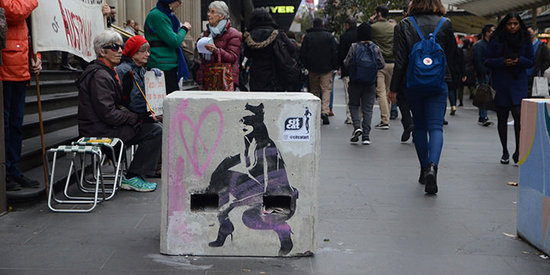'Bollart' plays an important part in perceptions of public safety
Media releaseMelbourne's 'Bollart' represents the city's will to remain vibrant in the face of uncertainty, according to two Deakin University urban design experts, who argue community repurposing of the bollards is critical in restoring feelings of public safety.
Dr Fiona Gray, an Adjunct Associate Professor at Deakin's Centre for Regional and Rural Futures (CeRRF), and Matt Novacevski, also a researcher at CeRRF, are two of the academics behind Melbourne's 'Lovability' index - a unique take on the city's liveability.
The pair has also looked closely at how "unkind architecture" can affect public perceptions of safety, through their research at the centre.
Mr Novacevski said the repurposing of Melbourne's safety bollards - installed following vehicle attacks in the city and around the world - should be encouraged and supported by authorities.
"When something like a big bit of blank concrete gets parachuted into the built environment, there's often a strong public reaction," he said.
"But what we have seen is the human city effectively growing over them and incorporating them in its culture through fabric covers, street art work and even the bollards' use as seating or tables for food and drinks.
"This is a really interesting phenomenon that reiterates Melbournians' pride in making place and ensuring freedom of expression.
"It's also a strong expression of defiance, not just in the face of threats, but any view that we have to take everything that's interesting out of an urban environment to make it safer."
Mr Novacevski said it was misguided to seek to design all risk out of an urban environment.
"Great cities have (and need to have) an edge that comes with and forms a vibrant culture and character. That edge is one element that people have identified in our Melbourne Lovability work," he said.
"The way people have responded to these bollards re-iterates the value people place on Melbourne's quirkiness and edginess as a kind of public asset. This gets amplified by the locations of the pieces around important gateway sites at Southern Cross and Flinders Street Station, and at the front of vital public space such as Fed Square.
"This 'Bollart' shows that we are fighting for the right to enjoy a vibrant, rich, urban environment. Research tells us that the more diverse a public space is, and the greater the number of different people that congregate there, the safer it is."
Dr Gray said people made an instantaneous decision on whether a place was safe based on the built environment before they were even conscious of it.
"Do these bollards actually make people feel safer? Or does it put in the forefront of our minds that this is an inherently unsafe environment? I think for some their sense of safety was lessened by having them there," she said.
"These bollards were something foreign and by decorating them and repurposing them, Melbournians are responding in a way to make them feel safe again.
"They are reclaiming this space as their own and making it something they can identify with. By reappropriating the bollards they become something people might even find endearing."
Dr Gray said the result was even better than anything the government could have designed deliberately.
"This is what urban designers call 'community place-making' - creating a built environment from the grassroots, and this bottom up approach ensures communities feel part of the process in reclaiming their city," she said.
"Because of that, it's critical that when the concrete bollards are replaced, the community has to be involved if we want them to feel safe and positive about these structures.
"I'd hate for the government to follow this happy accident with a 'place management' approach where they impose something on the space.
"They really have to bring the community along with what they want to achieve, because there's such a sense of attachment and ownership at play now with the bollards being reinterpreted."

